When it comes to portable power on the go, there are many options available. A portable power bank can help you squeeze a few extra charges out of your cellphone, before having to revert to an AC outlet. A UPS system can help keep your computer running in the event of a power outage. A generator provides long term, high capacity power for demanding equipment.
In many ways, a lithium power station is better than all of those options. Longer battery life, more versatility, and a compact design are all benefits exclusive to lithium. While small lithium batteries have been available for quite some time, we’re only just starting to see affordable lithium batteries that can handle demanding applications. The Goal Zero Yeti 1400 Lithium is considered by some to be the best on the market, but it’s price tag scares some people away. Does it actually perform that much better than alternative solutions? We decided to find out for ourselves.
First Look
As soon as we opened the box, we knew that the Goal Zero Yeti 1400 Lithium was a powerful device. Weighing in at 45 pounds, we were glad to have some large metal handles to help us move it. Although it’s larger, it’s still very similar to the Yeti 400. This portable power station can be charge in many different ways, and used to power almost any electric device you have in your home. Whether you’re charging it up for an off-grid camping trip, or stashing it in the basement in case of a power outage, having power on hand is incredibly useful.
Design & Durability
Whether you’re taking it outdoors or leaving it in the garage, the Yeti 1400 Lithium isn’t going to be easily damaged. The plastic enclosure is much more durable than most battery packs we’ve tested. It’s got rubber feet that absorb any impact from the ground, durable ridged plastic bumpers on all corners, and two large metal handles that make it easy to lug around.
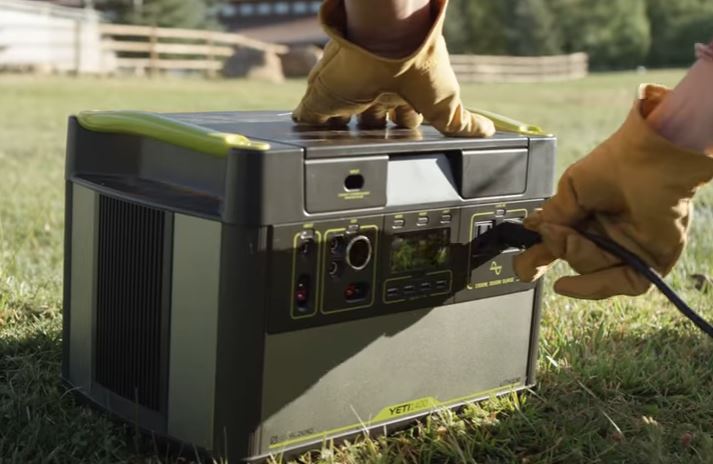
Although it’s one of the largest power stations we’ve used, the layout is still very similar to the other models. You’ve got two 120V outlets on the right side, four 2.4A USB ports, and the same 12V electrical port you’d find in a car. But there are a few extras. If you want 12V DC power, you can use either of the two BNC connectors. These are commonly found in RVs and Boats, and connectors are readily available to splice onto an existing option. You can also wire directly in to the connectors, which may be useful for running any 12V appliance with bare wires.
On the center of the Yeti is a large LCD display. Although the back light isn’t extremely bright, this screen uses very little power. At a glance, it will tell you some pretty important information. It shows you how much power is being drawn from the system, how much power is being put into it, and the estimated minutes of life remaining. When you’ve got limited power available, this information will help you ration it responsibly.
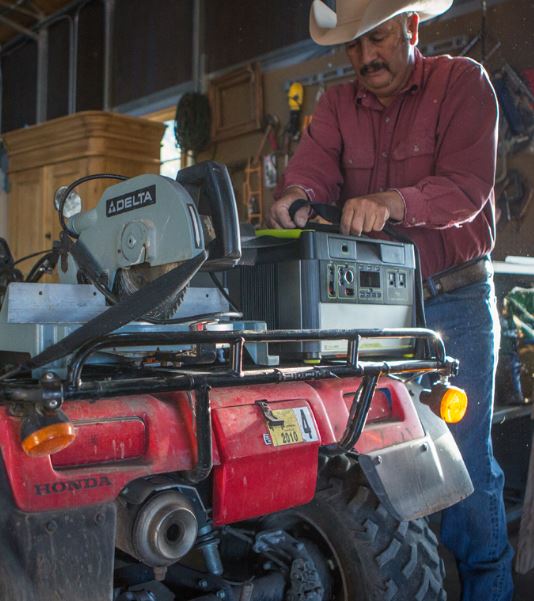
Charging
Before you can actually use the Yeti, you’ll need to charge up the battery. Goal Zero wanted to make sure that you can charge it in almost any circumstance, so there are a number of different options available. The quickest and easiest way is just to plug it into a standard 120V outlet. The battery ships with a little charge in it already, but it would take 25 hours to charge it from 0 to 100%.
Don’t have access to AC power? This battery has a built in solar charge controller, so you can quickly turn it into a noiseless, fume-free source of renewable energy. The rate of charge depends on how much sun you’d get in a day, and how many solar panels you have. If you max the input capacity out with an array of six 100 watt panels, you can fully charge the battery with just six hours of bright sunlight. With just a single panel, you’d need several summer days. Ideally, the solar capacity should be sized to replace whatever power you use during a day, starting the process off with a single full charge over AC.
If you’re not interested in buying solar panels, you can use your car to charge the battery. It comes with an adapter that plugs into your cigarette lighter, then into the power pole collection on the far left of the face plate. The nice thing about this input is that the power goes through its own separate charge controller. When running, most cars are actually producing something between 12.5 and 13.7 volts. Most charge controllers just restrict the flow of current, so only 12V can get through. But this controller uses all of the power it can get, charging more efficiently. Charging rate depends on your vehicle and alternator, but you can expect it to charge at half the speed as an AC outlet.
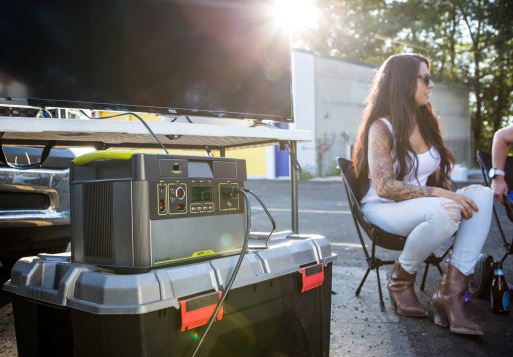
Capacity
With a 1425-watt hour battery, there is more than enough power for even your hungriest devices. With 118 hours of charge time for USB devices, you can be sure that your phone will be juiced up for days, if not weeks. A laptop could be charged from empty 16 times, and an LED strip light could run for 10 days non-stop. But what about higher power appliances? The pure sine wave inverter included can supply 1500 watts of continuous power, and up to 3000 watts of surge power. This will allow you to power appliances like a microwave, coffee pot, heater, or even a fridge. For the most part, these appliances will drain a lot of power if used consistently. But even a full-size fridge can run for up to 24 hours.
Features
Not enough power for you? There is an expansion port located under the lid. This port can be used to connect multiple Yeti 1400 batteries together. If you have some serious power demand, this allows you to expand it as much as necessary.
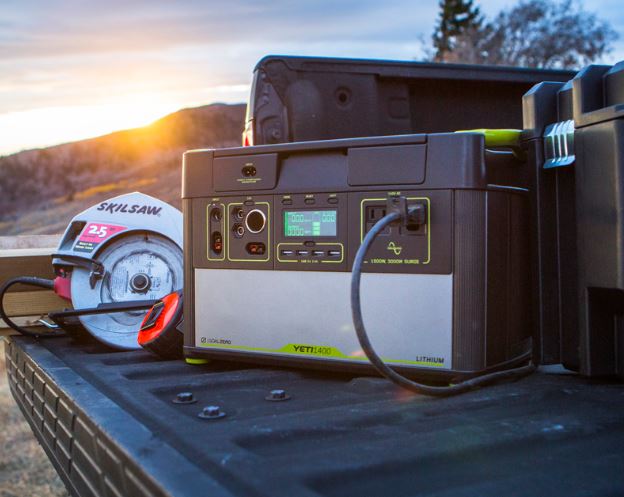
There is one feature in particular that stands out about the lithium batteries. Have you ever accidentally killed your car battery just by leaving an interior light on? Car batteries have a pretty high capacity. Often 1260 watt hours. But this power can only be used if it’s drawn at a specific rate. A 1 watt load might kill the battery in as little as five hours. Most battery backup systems use the same technology as car batteries. No matter how little power you’re drawing, the battery will never last more than 24 hours. Plus, even when not in use, lead acid batteries will self-discharge. To be kept full, they have to be plugged in charging at all times.
Lithium batteries don’t have either of these problems. If you’re not drawing any power, you can throw it on a shelf for a year and still have a full charge when you pull it out. When small loads are applied, no power is wasted due to battery inefficiency. Best of all, these batteries will typically last 5 to 10 times longer than standard backup batteries.
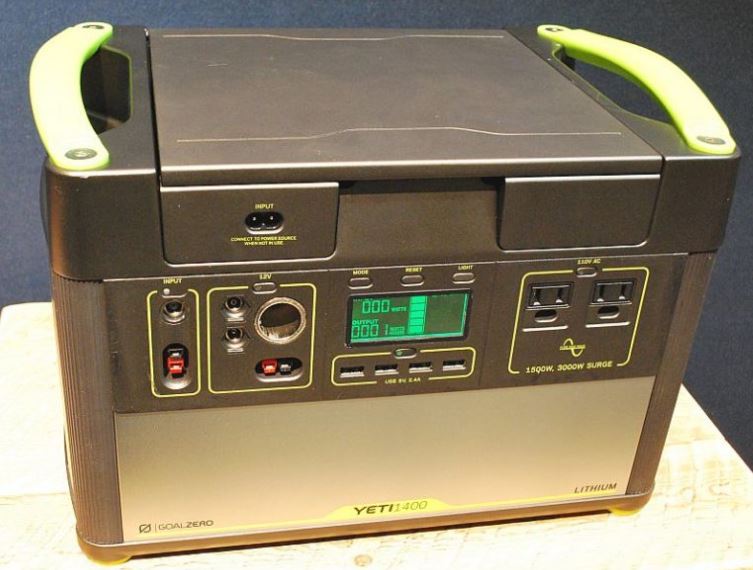
Disadvantages
Lithium is still a very new technology. While there are certainly some major benefits, this comes at a pretty steep price. If you need a reliable source of power right now, you’re not going to find anything like it on the market. But high capacity lithium batteries are coming down in price every day, so you can expect to see this price drop over time.
Final Verdict
Is this the first lithium backup battery on the market? No. But this is the first high-capacity, all-in-one lithium power station. You don’t need any fancy charge controllers, battery balancers, inverters, or DC-DC converters. Everything is included. Even if you don’t know the first thing about batteries, the included LCD display will tell you how much power you’re using, how much time you have before empty, and how quickly the battery is charging. This technology in inherently complicated, but the Goal Zero Yeti is Foolproof.
The Goal Zero Yeti 1400 Lithium has the capacity to run most smaller electronics for several days, if not weeks. Whether you want to keep the internet up and running so you can communicate, run the lights at your campsite, or keep your food cool in a power outage, this is the power station for you.
Of course, not everyone will need this much power. If you only need enough power for a weekend or two, check out our review of the Goal Zero Yeti 400 Lithium. It’s got much of the same features, but comes at a much lower price.
Meet Ry, “TechGuru,” a 36-year-old technology enthusiast with a deep passion for tech innovations. With extensive experience, he specializes in gaming hardware and software, and has expertise in gadgets, custom PCs, and audio.
Besides writing about tech and reviewing new products, he enjoys traveling, hiking, and photography. Committed to keeping up with the latest industry trends, he aims to guide readers in making informed tech decisions.

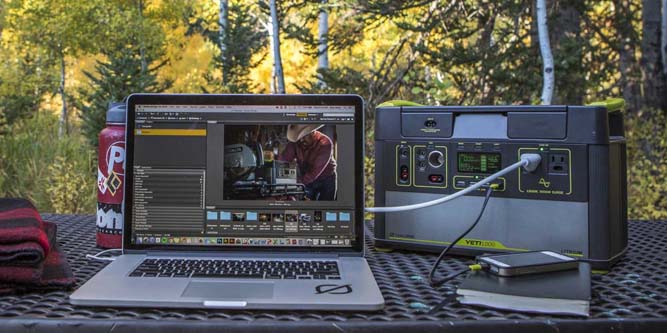
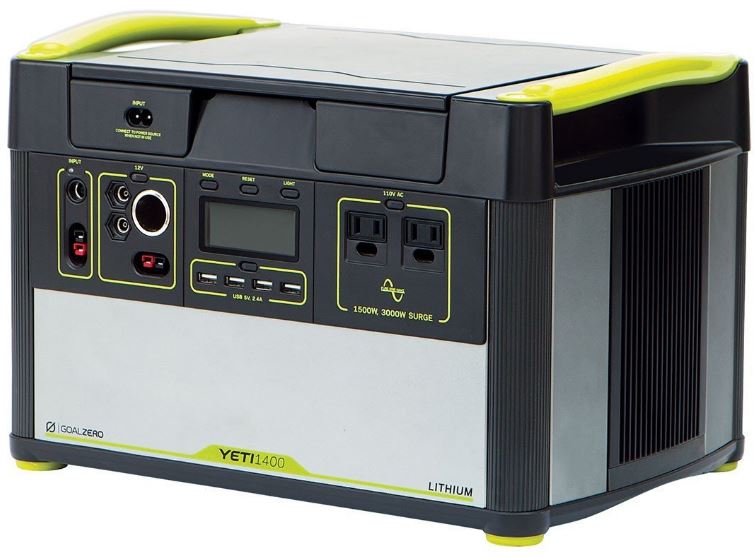
Great article. Just got the 1000 version (Costco exclusive).
High quality and very versatile.
I have a yeti 1400 power station. You used 6 100 watt panels (600 Watts)? By any chance did you use or try a home type solar panel Ex. 285 watt at apx 36 volts to power the unit or combind of the two? With home panels I paid 350 for the 285 watt panel for a long run in one place it can be cheaper to get to put on a RV two 285 watt panels. And the yeti . I am off grid in town ( talk about people getting mad when you have power and they don’t). I have 17 – 285 watt panels, 9 – 200 amp hour AGM glass Matt batteries, 2 – 80 and 1- 60 outback charge controllers and a 3000 watt inverted. I will use yeti for camping and other things. Will you be trying to play with the yeti more? Love to talk to you more about this and who knows what we can learn from eachother.
Thank you Don
May I ask what brand 28th panel you bought? Rand
Can we link a 400 AGM with the 1400 lithium? We already have the 400, but need more holding capacity.
Great article! As of today 11/1/17 it still shows that the unit reviewed (Yeti 1400 Lithium) is still not chainable however. So technically you can’t connect multiple Lithium 1400 together yet according to their page as mentioned in the article.
Can solar panels which aren’t made specifically for/by Ground zero be used with the yeti 1400?
The concept of this product is great. However, my experience with my Yeti 1400 has been poor. After spending over $3500 on a Yeti 1400 and accessories the price drops 20% a week later. My unit arrived D O A. Two weeks later I received a replacement unit which does not work as advertised. This unit was returned and I don’t know what is happening. No communication from Goal Zero or their dealer. If this is such a great product why am I left with a poor performing froduct fronm a poor performing company. A lot of to spend on a product I don’t even have. Buy something better.
Will a Yeti 1000 run a Craftsman 1.5 gallon air compressor? If so, then for how long?
I want to charge my Yeti 1400 with a Honda EU2000i gasoline generator. I want to charge it using the 12V out to avoid the inefficiency of going from 115V back through the GoalZero 115 VAC to 12 VDC wall charger. You mention in your review a 12V car to APP cord that came with your Yeti? Mine came with nothing like that. All the technical info from GoalZero warns NOT to charge from 12V source to avoid damage to the unit. Can you shed some light on this.
Would charging from the Honda gas generator using the 12V output to the APP input work without damaging the unit?
Also, I installed the optional MPPT module. Would using the inpu this module make this method less likely to cause damage?
I myself was all ready to save my money for the 1400 but reading the problem one person had after they bought the 1400 hs changed my mind. Especially the part about customer service. I’ve asked not once but 4 times three on their webpage about a statement they make in their description adverstisement page. It says if you want to charge it faster buy a second charger. So I asked how do you do that and where and how is it plugged into the Yeti 1400 and also does this same advice work for the 1000 too? I suppose I can PHONE them but I’m tired of not getting any feedback or info or help at all. Most places at least attempt to get back to you in reasonable time or within 72 hours. NOT GOAL ZERO. So with that in mind I’m thinking of buying the 1000 through Costco at 200 savings over their webpage and Amazon’s price brand new. Refurbished 1000’s are running at 844 dollars on Amazon right now too but some reviews are really knocking them. Even though one swears by it and thinks it great and no one needs go to the 1400. Also this person feels the 1000 as a refurb is the way to go it is considerable savings. approx 450 below the new price on Amazon and 150 approx below the new Costco Price. BUT Costco would support it for it’s full year warranty not sure Amazon and dealing directly with Goal Zero with their annoying habit of ignoring the customer or shopper would. Also the refurb is only warranted for three months which seems a bit short when they offered refurb 1400’s back in Dec of last year into January with full 6 month warranty. So at this time I’m leaning towards the 1000 via costco. And still will need to buy the wheel cart and the MPPT attachment that should have been included or built in with both 1000 and 1400 but they didn’t it’s now another 80 for that. If you buy the 3000 it is attached already. Shame on Goal Zero they don’t seem to have their heads in the game. If I were the person asking about the MPPT I’d PHONE THEM DIRECT go to their webpage and find the links to their 1-800 numbers for customer help. Don’t bother to e-mail they ignore all of those. Eventually I will probably end up with two 1000’s which I was trying to avoid. Two however does have some advantages in that if one were to fail I’d have a back up. Also I can charge one one day the other the next and probably keep my small portable freezer going easily over a 5-7 day period with this technique. There is quite a bit info about using muliple solar panels. I will have a 120 watt roll up one and built my own two 50watt bookcase model out of renology semi flex panels 3 years ago. They worked fine with two deep cell 800w solar boxes until both of those died one month apart exactly from the same symptoms. So they were bought to wait it out until Goal zero or someone else bulit a more powerful lithium battery box for camping. Took them long enough yet seems they have fallen short. Maybe that’s why they are ignoring requests for information about statements they have made..copy pasted right into the inquirey. I have a 27quart and a 45quart portable freezer. Both can be set as fridges but I use as freezers to keep ice used in my cooler so to avoid ice trips every few days and now and again a small iced treat too. The 45qt is now 6 years old and the 27 just a year. I needed a smaller one for just me when I camp as a solo older female. The larger one was heavy to deal with.
I just received my 1000 (after TWO previous failed shipments!) and like the power and overall initial feel of quality. It did a couple loads of clothes with both a washer and gas dryer running at the same time. My problem is not with capacity or longevity but more basic electrical design. The charger gets VERY hot. I did a chat session with Goal Zero and their only suggestion was to open the top cover. That kind of ruins the aesthetic of plugging in with the lid closed. The AC charger rate is current limited to only 60 watts on a 1000 wH battery. There is no upgrade charger. The solution is to buy a 2nd charger and plug in both at once. How dumb is that? The lithium units are not chainable AFAIK, so you just need to buy the biggest one you need. However, going to a bigger capacity does not change the inverter. It is still limited to 1500 watts continuous. I have now tripped out the unit @2000+ watts twice, now. Neither time was there any warning or soft shutdown. The entire system (including cooling fans) went dead until an internal fuse reset. I suspect this fuse to be a PTC rather than bimetallic, so who knows how long that protection will hold up? I’m seriously having some misgivings on this product and may end up returning it. I forgot to mention one of the 6mm output jacks appears to be assembled off-center. I fear it shorting if left unattended with this output turned on.
I too have not been able to get any answers from Goal Zero to my pre-sale questions. I have the same issue as others: the time it takes to re-charge the battery. I wanted to use this to power two refrigerators during extended power outages, but only during the night, when a generator is too noisy. I then want to recharge it during the day. However, no matter what options I choose, it looks like the 1400 cannot be reliably (i.e., not via solar) charged in less than 24 hours, except through some sort of multiple charger setup, which is not explained.
I keep looking for some sort of fast charge “hack,” which I assume is possible since the company itself does provide this mysterious “dual charger” method to decrease charge times.
I just went through an extended power outage, and used my old Coleman generator, as I have for a quarter century. I also used various spare UPS supplies. These two have exceedingly long (> 1 day) re-charge times. So, as the outage went along I realized that the only usable solution is the generator.
So, for me, as cool as these are, they are not for me.
i have a Yeti 1000 and a Yeti 150; can I combine the two to charge my full size 22 cu ft side by side
Amana refrigerator?